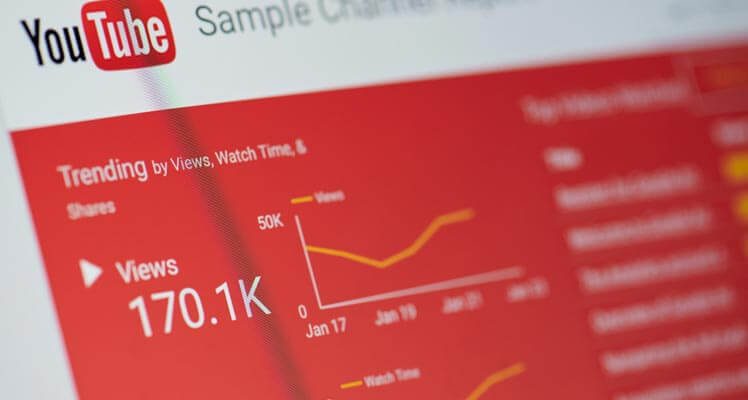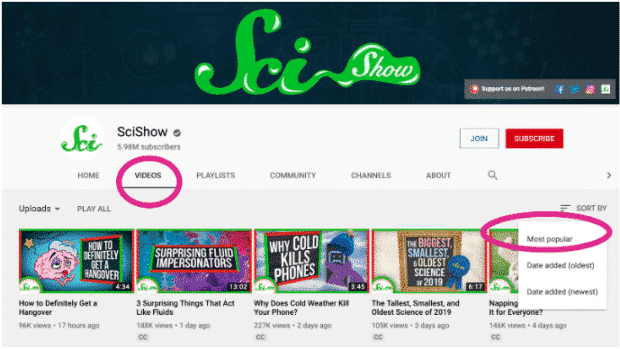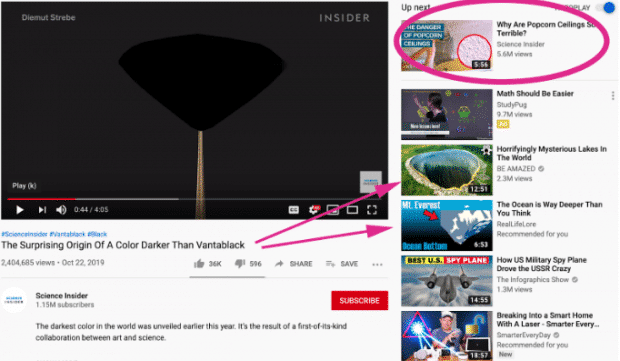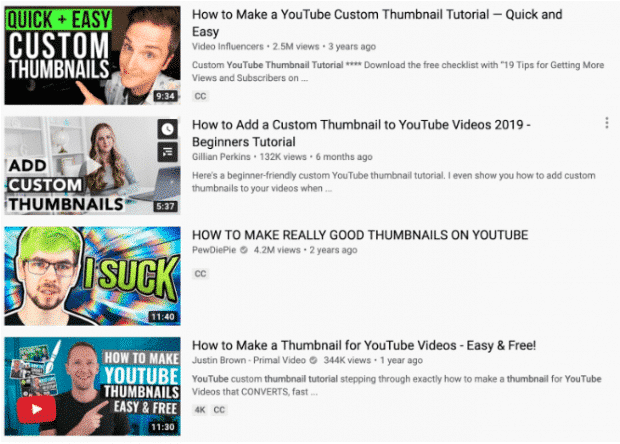Hey, 2020 is here, and you are here since you want to gain more views on YouTube.
YouTube is the second-largest site in the world. 2 billion people use it on monthly. 73% of adults in the U.S. are watching videos there. (We can go on, however, you could read all the newest YouTube stats on your own time.)
We have compiled this guide to point out all the simple wins that’ll amplify your brand’s message on YouTube, however, we are also going to detail a few of the more advanced techniques the professionals use.
Ready? Let’s get started.
12 methods to gain more views on YouTube
1. Make sure your YouTube basics are up to snuff
First we walk, then we run. Look at your fundamentals and be sure you have ticked all of the boxes.
Your basic YouTube housekeeping consists of considerations like:
- A consistent visual identity (your channel icon, YouTube channel art, and so on.)
- A completed and informative About part (unless you’re a breakout YouTube star like Joana Ceddia)
- Up-to-date contact info (so all of your potential customers and future brand partners could keep in touch)
2. Zero in on your particular niche (and your ideal audience)
Trust us, we are all about the actionable tips, however, successful YouTubers don’t skip this step, no matter how academic it sounds.
When you want to optimize your YouTube marketing strategy, you ruthlessly want to get precise and selective about your targets—and the content that’ll get you there.
Since you’re not creating videos for everybody. You are here for somebody particular: your audience.
For instance, YouTuber White Winter Whispers has been creating ASMR videos for several years. She has loads of the standard ASMR videos: crumple noises, brush noises, some whispered songs, et cetera. The videos are floating around 70-80,000 views, which is enough impressive, by most counts. However, she found her breakout two-million-view video with… Finnish tongue twisters.
What is the lesson here? The biggest strength of your YouTube brand is its unique angle on your topic or industry. Specificity is vital here.
Hot Tip: Have you worked up your audience personas yet? It’s quite like a Dungeons & Dragons character, except make it bizness.
3. Do your research, and improve your video’s search ranking
Yes, YouTube is a social platform, however, it is also a search engine. And all else being equal, one of the top methods to gain more views on YouTube is optimizing your videos for search.
Said differently, if your ideal viewer kinds in your selected keywords, you wish your video ranking close to the top of YouTube’s results list. That means you should know what your audience is looking for—tutorials, inspiration, or entertainment.
Ranking in search results is the best way to get brand new eyes—not just subscribers and people who are already excited about your channel—in your movies.
However, that is simpler said than done. So, what could you do to enhance your video’s search ranking on YouTube?
Research. You are going to want to use a tool as Google Keyword Planner (note that you will need to set up a Google Adverts account) to do two things:
- Find inspiration for your next video based on what people are already looking for (i.e., look at search patterns and see what keywords have lots of search queries, however, few videos, a.k.a. low competition)
- Take these relevant keywords and use them in your metadata (i.e., your video title, tags, description text, subtitles)
Pro Tip: When you have not already, now is the time to familiarize yourself with the YouTube algorithm. This AI determines not just search results, however, recommendations for that vital “what’s up next” sidebar, too. (See #4, below.) Just keep in mind that it all comes back to your ideal viewer: the algorithm does not care in case your video is “good,” it cares if a particular user wants to watch it. That being said, users wish to watch “good” videos typically.
4. Get recommended by use metadata after a popular video
In case your purpose is to gain more YouTube views, take a cue from the most prevalent videos in your niche.
Begin by having a look at your top competitor’s most popular video. (See their video library and sort by “most popular.”)
YouTube’s main purpose is to keep viewers on the platform for as long as possible (so that they will see as many adverts as possible.) Thus the algorithm’s job is to feed viewers one incredible video after another.
Of course, ‘incredible’ is in the eye of the beholder. A greater word may be ‘related’ or ‘fascinating.’
For instance, this prevalent science video on ultra-black material has just over 2.4M views. The YouTube algorithm’s “up next” video is from the same channel, however, it’s about, um… ‘80s home decor, I think? Below that’s an advert. And below that’s where the algorithm gets fascinating.
How does YouTube figure that a person excited about, say, the purest expressions of the color of despair, may be excited about “horrifyingly mysterious” lakes? Or vertiginous oceanic depths?
Well. YouTube has stated that the algorithm recommends:
- Videos from the same channel
- Videos that lots of people like, based on engagement, watch time, and views
- Videos particular person may like, based on their viewing history
- Videos with related or similar metadata (i.e., titles, tags and descriptions)
The only point you could control here is that fourth one.
However, before you go ahead and simply copy-and-paste a more prevalent video’s metadata over to your copycat video (as some YouTube gurus recommend, although, we will not name names), please take a moment and think about your audience.
They are not going to want to watch the same video again. Maybe the first video raised a new query that needs answering, or there is a fascinating tangent to be explored. How could your video add value to what they just saw so that they will want to click on it?
Take the ball and run with it.
Pro Tip: Not like other video metadata like titles and descriptions, YouTube video keywords are not listed visibly. In order to see them, right-click on the webpage and choose “View Page Source.” Then CTRL-F “keywords” till you find the list:
And Another Pro Tip: If you are selecting keywords, think like a librarian. Describe your video’s topic and describe its overall category, and consider other words a person may use to seek for that topic.
For instance, the tongue-twister video from #2 may have the following keywords:
- Topic: Finnish tongue twisters
- Category: ASMR, foreign languages
- Synonyms: unintelligible ASMR, tough languages, soothing ASMR, Finnish ASMR, Suomi ASMR
5. Improve your views on Youtube with custom thumbnails
If your potential viewers are in discovery mode—skimming by searching results and recommendations—thumbnails are a serious part of how they determine what to watch.
Sadly, lots of recommendation out there is a graphic designer’s nightmare: screaming fonts, cluttered info. The self-appointed experts even are a little loud:
However, we are not here to police individuals’ abuse of neon green. So, objectively speaking, what are the properties of a perfect thumbnail?
- The thumbnail is clear and accurate about the video it’s describing (in case your thumbnail misleads people into clicking, YouTube will know because your watch time will go down when the viewer gets annoyed and stops watching. The algorithm will not like that.)
- The thumbnail stands out.
- The thumbnail works together with the video’s title.
‘Standing out’ could be as simple as selecting a bright color. Or ensuring your giant hi-res face is creating a weird expression in good lighting. However, it’s just as likely that your niche is filled with high-key visuals, shrill, and the best way your channel could stand out is by being the calm, minimalist voice of reason.
Alternately, you could always nix the production values and go for fully authentic no-filter vibes. It doesn’t hurt Joana Ceddia’s view counts.
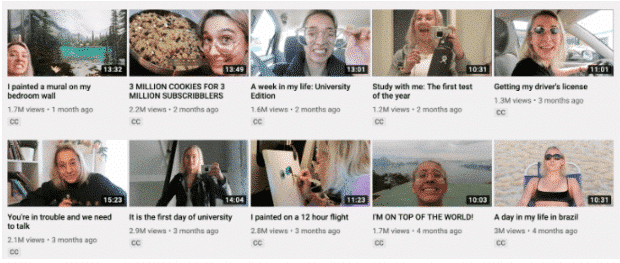
6. Multiply your views by creating playlists
Managing and making youtube video playlists is the best way to reduce the chances that a viewer will move on to another channel once they have consumed your content.
Why? Because playlists do Netflix rules: once a video ends, the next starts.
Because you have already finished the hard work of helping your viewer discover your video, click on it, and watch the entire thing, it makes sense to guide them towards the content they are going to want next. (And, suddenly, before they realize it, they have binged the entire first season of Just for Baths.)

